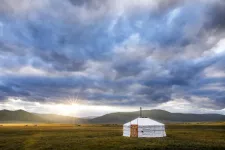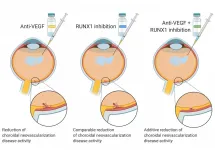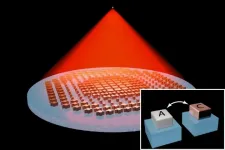Genomic insights into the origin of pre-historic populations in East Asia
Integrating evidence from genetics and archaeology resarchers shed light into East Asia's population history
2021-02-22
(Press-News.org) Diverse East Asians derive ancestry from a coastal expansion tens of thousands of years ago
Researchers have long debated whether the peopling of East Asia by modern humans occurred mainly via a coastal or interior route. The answer is probably both. "Indigenous Andaman islanders of the Bay of Bengal, Indigenous Tibetans, ancient Taiwanese, and ancient and modern Japanese all derive ancestry from a deep shared lineage that split from other East Asian lineages more than 40,000 years ago," says David Reich, co-senior author of the study, who is a Professor of Genetics and Human Evolutionary Biology at Harvard University and an Investigator of the Howard Hughes Medical Institute. "The simplest way to explain this is if some of the earliest modern humans in East Asia spread along a coastal route linking southeast Asia, coastal China, and the Japanese Archipelago." In contrast, the 40,000 year old Tianyuan individual--along with present-day and early Holocene people from Mongolia and the Amur River Basin--derive almost all their ancestry from a different early splitting lineage. This lineage plausibly expanded by an interior route and contributed in the highest proportion to ancient Mongolians, people of the Amur River Basin, and early farmers from the West Liao and Yellow River regions.
How East Asian populations got to be how they are today
Today there is a fairly high degree of genetic homogeneity in East Asia, reflecting mixtures of deeply splitting lineages that occurred especially in the last ten thousand years. To connect the population structure of present-day East Asians to ancient lineages, co-first author Chuan-Chao Wang, Director of the Institute of Anthropology at Xiamen University, led a collection of genome-scale data from 383 people from 46 diverse populations from East Asia. The study team also generated genome-scale ancient DNA data from 166 individuals from mainland China, Taiwan, Mongolia, Japan and Russia, ranging in age up to about 8,000 years ago. Wang led the statistical analysis of these data, along with previously published data from other research groups, to understand how the ancient and modern people were connected with each other. Say Wang: "With high resolution modern and ancient data, we can connect the dots between ancient and modern East Asians."
Testing the extent to which present-day language distributions reflect ancient farming expansions
Increases of population densities in and around centers of domestication created demographic expansions that in principle could have spread people and languages. The authors tested several hypotheses about whether particular farming expansions were connected to language spreads.
The first is the "Transeurasian hypothesis": the theory that languages of the Mongolic, Turkic, Tungusic, Koreanic, and Japonic families may descend from a proto-language associated with the expansion of early millet farmers around the West Liao River in northeast China. The study confirms a shared genetic link between present-day people speaking Transeurasian languages: they all have large proportions of ancestry from the deeply splitting Tianyuan-related lineage. However, this link dates to before farming expansions, as Mongolic, Turkic, and Tungusic speakers do not have the characteristic mixture of ancient lineages that is a signature of West Liao River farmers. However, West Liao River farmers do appear to be an excellent candidate for the primary source population for present-day Korean and Japanese people.
A second hypothesis concerns the origins of Sino-Tibetan languages. The authors show that most of the ancestry of both Tibetans and Han Chinese comes from a population closely related to Yellow River farmers who lived around 3,000 BCE. "The findings show that Neolithic farmers cultivating foxtail millet in the Upper and Middle Yellow River Basin expanded southwest toward the Tibetan Plateau to spread present-day Tibeto-Burman languages, and east and south towards the Central Plains and eastern coast to spread Sinitic languages including the linguistic ancestor of Han Chinese," says co-first author Huqin Zhang, a professor at Xi'an Jiaotong University, China.
A third hypothesis concerns the spread of languages and rice farming. Previous ancient DNA analysis correlates the spread of rice farming across Southeast and South Asia with Austroasiatic, Tai-Kadai, and Austronesian languages. Through modelling of diverse Indigenous groups from southern China, this study strengthens the connections to these diverse language groups.
How West and East Eurasian peoples met and mixed
Mongolia falls near the eastern extreme of the Eurasian Steppe, and archaeological evidence shows that throughout the last ten thousand years the region was a conduit for cultural exchanges between East and West Eurasia. For example, the Afanasievo culture, an eastward extension of the Yamnaya steppe pastoralist culture, impacted Mongolia around the turn of the third millennium BCE, although in contrast to Europe, where Yamnaya ancestry became permanently established after it first arrived, a near-complete displacement of the ancestry brought by these migrants occurred in Mongolia following the decline of the Afanasievo culture. Strikingly, ancestry from the initial Yamnaya expansion survived in northwest China at least into the Iron Age. "This increases the plausibility of the theory that the Yamnaya expansion was a vector of spread, not only of the ancestors of all spoken Indo-European languages, but also of the early-branching Tocharian languages attested from written records in Iron Age western China," says co-senior author Johannes Krause, professor and director at the Max Planck Institute for Evolutionary Anthropology in Leipzig, Germany.
"Our analysis also documents subsequent ancestry impacts from the west on Mongolia," says co-senior author Ron Pinhasi of the University of Vienna. "One of these brought Yamnaya ancestry back to Mongolia more than a millennium after it first appeared, this time mixed with about a third ancestry from European farmers." Pinhasi adds: "The other impact from the west began about 4,500 years ago, bringing ancestry along the Inner Asian Mountain Corridor related to the people of Iran and Central Asia. However, this ancestry made only transient early contributions to populations in Mongolia and western China, and does not appear again in our ancient DNA time for two millennia."
INFORMATION:
Original publication:
Chuan-Chao Wang et al.
Genomic insights into the formation of human populations in East Asia
Nature, 22 February 2021, DOI: https://doi.org/10.1038/s41586-021-03336-2
Contact:
Dr. Chuan-Chao Wang
Institute of Anthropology, Xiamen University, China
wang@xmu.edu.cn
Prof. Dr. Johannes Krause
Max Planck Institute for Evolutionary Anthropology, Leipzig, Germany
krause@eva.mpg.de
Dr. Ron Pinhasi
University of Vienna, Austria
ron.pinhasi@univie.ac.at
Prof. Dr. David Reich
Harvard Medical School, USA
reich@genetics.med.harvard.edu
[Attachments] See images for this press release:

ELSE PRESS RELEASES FROM THIS DATE:
2021-02-22
Philadelphia, February 22, 2021 - Runt-related transcription factor 1 (RUNX1) has been linked to retinal neovascularization and the development of abnormal blood vessels, which result in vision loss in diabetic retinopathy. Now, scientists have found that RUNX1 inhibition presents a new therapeutic approach in the treatment of age-related macular degeneration (AMD), which is the leading cause of blindness in the elderly worldwide. Their END ...
2021-02-22
Polished glass has been at the center of imaging systems for centuries. Their precise curvature enables lenses to focus light and produce sharp images, whether the object in view is a single cell, the page of a book, or a far-off galaxy.
Changing focus to see clearly at all these scales typically requires physically moving a lens, by tilting, sliding, or otherwise shifting the lens, usually with the help of mechanical parts that add to the bulk of microscopes and telescopes.
Now MIT engineers have fabricated a tunable "metalens" that can focus on objects at multiple depths, without changes to its physical position or shape. The lens is made not of solid glass but of a ...
2021-02-22
Children exposed to air pollution, such as wildfire smoke and car exhaust, for as little as one day may be doomed to higher rates of heart disease and other ailments in adulthood, according to a new Stanford-led study. The analysis, published in Nature Scientific Reports, is the first of its kind to investigate air pollution's effects at the single cell level and to simultaneously focus on both the cardiovascular and immune systems in children. It confirms previous research that bad air can alter gene regulation in a way that may impact long-term health - a finding that could change the way medical experts and parents think about the air children ...
2021-02-22
Abu Dhabi, UAE, February 22: By engineering common filter papers, similar to coffee filters, a team of NYU Abu Dhabi researchers have created high throughput arrays of miniaturized 3D tumor models to replicate key aspects of tumor physiology, which are absent in traditional drug testing platforms. With the new paper-based technology, the formed tumor models can be safely cryopreserved and stored for prolonged periods for on-demand drug testing use. These cryopreservable tumor models could provide the pharmaceutical industry with an easy and low cost method for investigating the outcomes of drug efficacy, potentially bolstering personalized ...
2021-02-22
DURHAM, N.C. - The COVID-19 pandemic has heaped additional financial strains, childcare complications and other problems on already-burdened caregivers of children diagnosed with cancer, according to a study from researchers at Duke Health and other institutions.
Surveying 360 parents and caregivers of children currently in treatment or still being monitored for cancer, the researchers found that half had to cancel or delay appointments, 77% reported increased feelings of anxiety and of those who had lost jobs or wages, 11% struggled to pay for basic needs.
The survey findings appear online this month in the journal Pediatric Blood & Cancer.
"Parents and caregivers ...
2021-02-22
HOUSTON - (Feb. 22, 2021) -Tuberculosis bacteria have evolved to remember stressful encounters and react quickly to future stress, according to a study by computational bioengineers at Rice University and infectious disease experts at Rutgers New Jersey Medical School (NJMS).
Published online in the open-access journal mSystems, the research identifies a genetic mechanism that allows the TB-causing bacterium, Mycobacterium tuberculosis, to respond to stress rapidly and in manner that is "history-dependent," said corresponding author Oleg Igoshin, a professor of bioengineering at Rice.
Researchers have long suspected that the ability of TB bacteria to remain dormant, sometimes for decades, ...
2021-02-22
COLUMBUS, Ohio - Fool the novel coronavirus once and it can't cause infection of cells, new research suggests.
Scientists have developed protein fragments - called peptides - that fit snugly into a groove on the SARS-CoV-2 Spike protein that it would normally use to access a host cell. These peptides effectively trick the virus into "shaking hands" with a replica rather than with the actual protein on a cell's surface that lets the virus in.
Previous research has determined that the novel coronavirus binds to a receptor protein on a target cell's surface called ACE2. This receptor is located on certain types of human cells in the lung and nasal cavity, providing SARS-CoV-2 many access points to infect the body.
For this work, Ohio State University scientists designed and tested peptides ...
2021-02-22
Intravenous injection of bone marrow derived stem cells (MSCs) in patients with spinal cord injuries led to significant improvement in motor functions, researchers from Yale University and Japan report Feb. 18 in the Journal of Clinical Neurology and Neurosurgery.
For more than half of the patients, substantial improvements in key functions -- such as ability to walk, or to use their hands -- were observed within weeks of stem cell injection, the researchers report. No substantial side effects were reported.
The patients had sustained, non-penetrating spinal cord injuries, in many cases from falls or minor trauma, several weeks prior to implantation of the stem cells. Their symptoms ...
2021-02-22
ITHACA, N.Y. - In the same way that Lego pieces can be arranged in new ways to build a variety of structures, genetic elements can be mixed and matched to create new genes, according to new research.
A long-proposed mechanism for creating genes, called exon shuffling, works by shuffling functional blocks of DNA sequences into new genes that express proteins.
A study, "Recurrent Evolution of Vertebrate Transcription Factors by Transposase Capture," published Feb. 19 in Science, investigates how genetic elements called transposons, or "jumping genes," are added into the mix during evolution to assemble new genes through exon shuffling.
Transposons, first discovered in the 1940s by Cornell alum and Nobel Prize-winner Barbara McClintock '23, M.A. '25, Ph.D. '27, are ...
2021-02-22
ITHACA, N.Y. - A new study identifies a mechanism that makes bacteria tolerant to penicillin and related antibiotics, findings that could lead to new therapies that boost the effectiveness of these treatments.
Antibiotic tolerance is the ability of bacteria to survive exposure to antibiotics, in contrast to antibiotic resistance, when bacteria actually grow in the presence of antibiotics. Tolerant bacteria can lead to infections that persist after treatment and may develop into resistance over time.
The study in mice, "A Multifaceted Cellular Damage Repair and Prevention Pathway Promotes ...
LAST 30 PRESS RELEASES:
[Press-News.org] Genomic insights into the origin of pre-historic populations in East Asia
Integrating evidence from genetics and archaeology resarchers shed light into East Asia's population history




